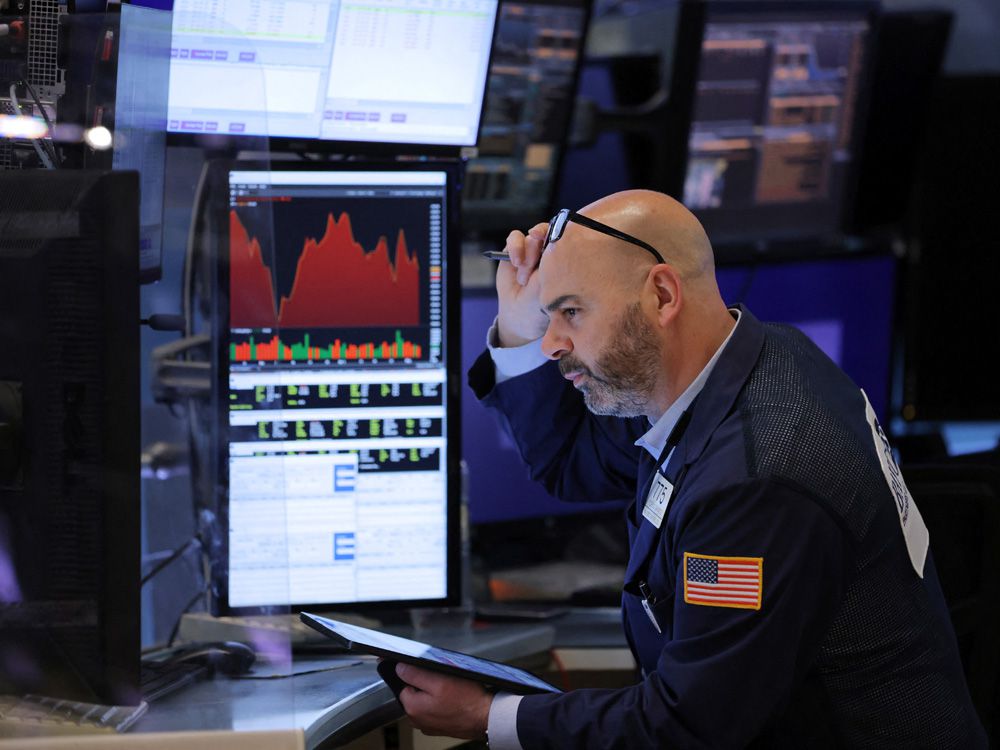Martin Pelletier: We have not yet seen the across-the-board capitulation of previous meltdowns
An exhausted trader slumps in his chair at the Toronto Stock Exchange October 19, 1987, known as Black Monday. The Canadian Press The daily market swings have been quite amazing to watch, but it appears many are still trying to time the market by buying the selloffs, a strategy that has been more like catching a falling knife, since the S&P 500 has sold off more than 18 per cent from its January highs.
Advertisement 2 This advertisement has not loaded yet, but your article continues below.
For those wondering if we have finally hit rock bottom, remember that corrections can significantly vary in length from a few months to a few years, with the average S&P 500 peak-to-trough drawdown being 24 per cent during the median recession since the Second World War, according to Goldman Sachs Global Investment Research.
That said, there are some sizable outliers, including the 48-per-cent correction in 1973, 49 per cent in 2001 and 57 per cent in 2008.
For some additional perspective, the S&P 500 is only down five per cent over the past 12 months and trading at levels similar to March 2021. We have also not yet seen the across-the-board capitulation seen in previous meltdowns. Less than 30 per cent of the S&P 500’s constituents have hit a one-year low, according to Citi strategists cited by Bloomberg, compared to 50 per cent in 2018 and 82 per cent during the global financial crisis in 2008.
Advertisement 3 This advertisement has not loaded yet, but your article continues below.
How much longer will this selloff continue? Markets can quickly rebound, as they did during the COVID-19 correction in 2020, or take years, as they did from 1929 to 1932, 1973 to 1974, 2000 to 2002, and 2007 to 2009.
We think this one feels a bit different though, because both stocks and bonds are correcting and investors have become all too comfortable and overweight on duration exposure, thanks to central bankers and their very accommodative policies since the 2008 financial crisis.
But persistent inflation is forcing central bankers to reluctantly raise interest rates, which impacts those stocks and bonds most sensitive to higher rates such as longer-term government and corporate bonds as well as certain stocks in the technology sector.
Advertisement 4 This advertisement has not loaded yet, but your article continues below.
Looking ahead, we are worried as this monstrous trade continues to unwind that there is the potential for it to play out like it did during the 2000 tech bubble, ushering in the next commodity cycle that at the time was underinvested in like today.
Back then, according to Marathon Research Advisors research, the tech sector rallied nearly 1,582 per cent, dwarfing the 161 per cent gain by commodity stocks, from 1990 to the peak in 2000, but then tech stocks lost 59 per cent during the following decade while commodity stocks rallied 253 per cent.
Fast forward to today and Marathon calculates tech stocks are up 582 per cent since 2009 while commodity stocks are down 34 per cent.
One of our favourite commodity fund managers, French businessman Pierre Andurand, had some interesting insight on this via Twitter.
Advertisement 5 This advertisement has not loaded yet, but your article continues below.
July 14th 2008: Nasdaq at 1,800, SP500 at 1280, Brent at $147
May 19th 2022: Nasdaq at 11,740, SP500 at 3,850, Brent at $107
And many think that stocks are cheap after the move down, and that oil is expensive after the move up
— Pierre Andurand 🇺🇦🌻🇫🇷🇪🇺 (@AndurandPierre) May 19, 2022 This doesn’t mean great tech companies are going out of business. Far from it. But it may mean they’re not good stocks. Take Cisco Systems Inc., an outstanding company that was trading at more than US$77 in March 2000, fell to US$10.50 in September 2002 and slowly recovered to about US$42 today.
More On This Topic Here’s how to turn the gut-wrenching test of a market correction to your advantage Martin Pelletier: The markets are throwing a tantrum, but this time central banks may not bail them out Martin Pelletier: Two common mistakes that can cost investors in these volatile times This is an extreme example, but it is one that nonetheless brings attention to the risks of making concentrated bets on any one sector. It has handsomely paid off over the past decade or so, resulting in superior performance for those managers who overweighted the tech-heavy S&P 500, but perhaps inflation will be the catalyst to rebalance the market back into other more traditional sectors such as commodities stocks.
Instead of doubling down and catching falling knives, investors might want to take a different, more balanced approach, just in case this correction in long-duration stocks plays out like it has in the past.
Martin Pelletier, CFA, is a senior portfolio manager at Wellington-Altus Private Counsel Inc, operating as TriVest Wealth Counsel, a private client and institutional investment firm specializing in discretionary risk-managed portfolios, investment audit/oversight and advanced tax, estate and wealth planning.
Financial Post Top Stories Sign up to receive the daily top stories from the Financial Post, a division of Postmedia Network Inc.
By clicking on the sign up button you consent to receive the above newsletter from Postmedia Network Inc. You may unsubscribe any time by clicking on the unsubscribe link at the bottom of our emails. Postmedia Network Inc. | 365 Bloor Street East, Toronto, Ontario, M4W 3L4 | 416-383-2300
